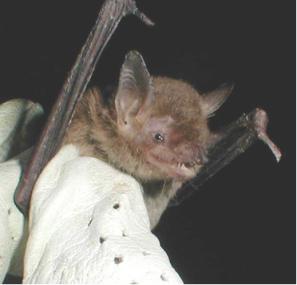Cave myotis facts for kids
Quick facts for kids Cave myotis |
|
|---|---|
 |
|
| Conservation status | |
| Scientific classification | |
| Genus: |
Myotis
|
| Species: |
velifer
|
 |
|
The cave myotis (Myotis velifer) is a type of bat that belongs to a group called Myotis. It's part of the Vespertilionidae family, also known as vesper bats. This bat was first described in 1890.
Contents
What Does the Cave Myotis Look Like?
The cave myotis is bigger than most other bats in the Myotis group. Its forearm, which is like its arm bone, measures about 37 to 44 millimeters (1.5 to 1.7 inches) long.
This bat has brown fur and short ears. You can tell it apart from other large Myotis bats because it has a small patch of bare skin on its back. Interestingly, male cave myotis bats are usually smaller than the females.
Where Do Cave Myotis Bats Live?
You can usually find the cave myotis living in caves. They also sometimes make their homes in old mines or even buildings. The biggest groups of these bats live in southwest Kansas and in Mexico.
During the winter, when bats hibernate, huge groups of over a thousand cave myotis bats have been seen hanging from the ceilings of caves.
What Do Cave Myotis Bats Eat and How Do They Behave?
The cave myotis is an insectivore, which means it eats insects. Its favorite food is moths. To find its prey, the bat uses echolocation. This is like using sound waves to create a map of its surroundings. They usually start hunting about one or two hours after the sun sets.
Because they are larger and have wings that are good for flying long distances, cave myotis bats can fly farther from their home roosts to find food than other Myotis bats. When there aren't many insects around, like in spring and autumn, they eat less food.
Female bats eat more than males, especially when they are pregnant (during gestation) or feeding their babies milk (during lactation). Young bats learn to hunt very quickly. They start joining the adults to find food when they are only about four weeks old. By the time they are six to eight weeks old, they eat as many insects each day as an adult bat!
Cave myotis colonies go into hibernation from the middle of October until April. These bats can live for about thirteen years.
Do Cave Myotis Bats Have a Good Sense of Direction?
Most bat species are very good at finding their way home, a skill called homing ability. Scientists are still trying to understand exactly how bats do this.
However, the cave myotis is a bit different. Unlike many other bats, it doesn't have a very strong homing instinct. Some scientists think that a bat's homing ability might depend a lot on its sense of smell (olfactory sense) and its eyesight.
See also
 In Spanish: Myotis velifer para niños
In Spanish: Myotis velifer para niños


